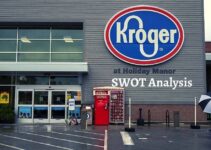Swot analysis of Lego. LEGO or The Lego Group is a Danish plastic toy manufacturing multinational company. Ole Kirk Christiansen was the founder of Lego, and he laid the foundation of the company on August 10, 1932. The company started producing brick toys in 1949. The headquarter of the company is in Billund, Denmark.
Lego falls under the category of the world’s largest toy manufacturing company as of 2021. The company started its business with the construction of wooden toys. The brand received the patent of interconnecting construction brick toy designs in 1958. The patent changed the course of Lego’s fortune and it became it multinational billionaire brand.
Some of the main products and services are;
- Puzzles
- Bed Lenin
- Watches
- Lifestyle clothes
- Educational material for kindergarten & schools
- Media products like films, books, videos, music, software
- Incorporating robotics
- basic construction-toy theme
According to an estimate, the annual revenue of Lego was 27 billion dollars by the mid of 2022, and it has increased by 17%. Out of which, the net profit of the toy manufacturing company was 1.33 billion Euros in 2020. However, the company has employed more than 17,431 employees to manage its worldwide operations.
Lego’s top competitors are;
- Leapfrog,
- VTech,
- Meccano,
- Automoblox,
- Hasbro,
- Hot Wheels,
- Mobile Suit Gundam,
- Mattel,
- Nerf,
- Barbie,
- Fisher-Price,
- Bandai Namco.
Today, we’ll discuss the swot analysis of Lego. It’s going to analyze the internal and external factors impacting the world’s leading toy manufacturing company. Here’s the swot analysis of Lego as follows;
Strengths of Lego
Lego Community
Lego has a platform under the name of “Lego Ideas” where Lego toy lovers share their creative gaming ideas. In fact, the platform organizes contests and other events in order to retain the interest of users. The fans send their unique ways of brick construction ideas to the company, and the winner gets awards and recognition from the brand. It’s an excellent activity to increase brand loyalty and engagement with customers.
E-commerce
The pandemic crisis has amplified online shopping and e-commerce trends because of the worldwide lockdown. Fortunately, Lego has already established an online toys platform alongside brick & mortar stores. According to an estimate, one out of every third of toy sale comes from online store, and the total sale has amplified by 27% in 2020.
Licensing
Lego has made licensing deals with franchises like F.R.I.E.N.D.S., Lord of the Rings, Marvel, DC Comics, Harry Potter, and Star Wars. It has allowed the toy manufacturing brand to attract new gaming fans and increase sales and profit.
Innovation & Creativity
Innovation and creativity are very important elements of Lego. In fact, children tend to have a higher intellectual skills when playing Lego. However, the company updates and refreshes 60% of its catalog, so that the customers don’t get bored.
Global Brand
Lego is a global multinational toys brand and the company is running its business in over 130 countries worldwide. The brand also has a chain of more than 570 stores in various countries to give a real-life toy shopping experience along with an online store.
Brand Value
According to an estimate by Interbrand, the brand value of Lego in 2022 was 11,836 million dollars, and it has increased by +30%. The company ranked 63rd position of the Best Global Brand in 2020. However, the toy manufacturing company ranked at the 92nd position of the World’s Most Valuable Brands 2020 according to Forbes.
Weaknesses of Lego
Counterfeit
Many counterfeit manufacturers are selling their cheap quality products in the market. They offer almost identical products and many new users don’t perceive any difference. They end up buying copycats and counterfeit products. The brand hasn’t been able to take any action about it, even though it decreasing the company’s sales and reputation.
Clones
Ever since Lego’s patent rights expired in the 1980s, many competitive toy manufacturing companies have jumped into the construction brick toy niches. Now, they’re selling the same products and the company can’t take any legal actions against them.
eOne
eOne is Hasbro’s kid TV network. Hasbro is one of the main competitors of Lego, and it’s promoting its toys and other products on the platform. The growth of the TV network is increasing the sale of the competitive brand. It’s negatively impacting the sale of Lego.
Video Games
The trend of playing video games is addictive and it has become very popular among children and teenagers. In fact, it’s even more fascinating than Lego’s construction bricks. The growth of audio/visual games is decreasing the market share of toy companies.
High Prices
The research and licensing cost compels Lego to increase the retail price. In fact, the company’s toys are far more expensive than competitors. That’s why price-conscious customers prefer the toys of affordable competitive companies.
Opportunities available to Lego
Learning & Education
Lego has laid the foundation of “Lego Foundation” and “Lego Learning” to foster education and learning through play. It goes alongside with company’s mission of developing the children for the future.
Personalized Experience
Lego is a creative game and it allows children to build whatever they want. Sometimes they come up with such unique ideas that baffle the adult mind. Now, the company should consider adding a personal touch that competitors aren’t providing. The brand could borrow some of the ideas from competitive companies.
Subscription Model
The subscription business model means Lego could offer new ideas and boxes to the monthly subscribers for a certain fee. It would increase user engagement and brand loyalty. Most importantly, it would allow the company to make use of the platforms’ ideas.
Virtual Reality
Lego is offering augmented reality games. Here the children have to use toys to trigger a response in augmented reality. The augmented reality game has many limitations and it’s far from the virtual reality gaming concept. If the company launches virtual reality games, it would attract a plethora of new gamers.
Market Expansion
According to an estimate, approximately more than 90% of Lego gamers (2 billion people) would be from Asia, Africa, and Latin America. Therefore, the company should shift its focus from Europe and North America, and enter the Asian and developing markets.
Threats Lego has to face
Competitors
The construction bricks toy market is competitive and competitors are looking for anything to gain a competitive advantage. Therefore, Lego should boost its research and innovation process in order to gain a competitive edge and win the market competition.
Online Games
Online games are very interesting and their market share is growing at an exponential rate. Their increasing popularity and widespread usage pose a severe threat to the business of Lego.
Environmental Issues
Crude oil and plastic are the manufacturing ingredients of Lego toys. It takes hundreds of years for plastic to decompose and becomes part of nature again. Therefore, the chief raw material plastic puts all odds in the favor of the company.
Economic Recession
The pandemic crisis hasn’t much impacted the sale of Lego. But the post-pandemic economic recession would because millions of people to become unemployed worldwide. When people have limited money, they won’t spend on toys.
Conclusion: Lego Swot Analysis Example Company
After an in-depth study of the swot analysis of Lego, we’ve concluded that Lego is indeed the world’s leading toy-manufacturing multinational company. Counterfeit manufacturers, economic recession, usage of plastic, and online video games are some of the main challenges. Lego should utilize its brand name and capital to expand its market and product portfolio by launching video games; while keeping in mind the internal strengths weaknesses; external opportunities threats of toy company swot analysis example company.

Ahsan Ali Shaw is an accomplished Business Writer, Analyst, and Public Speaker. Other than that, he’s a fun loving person.


